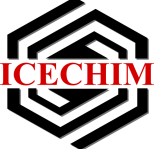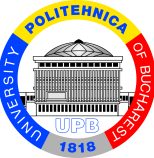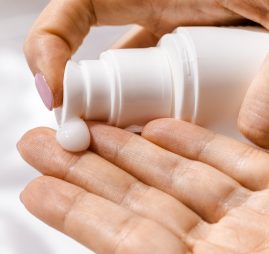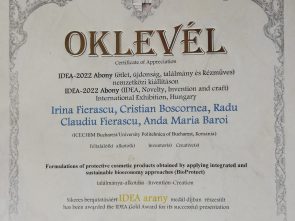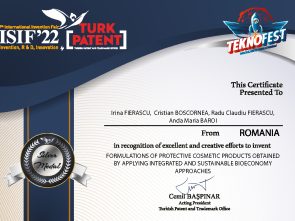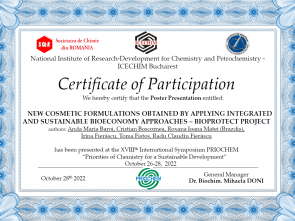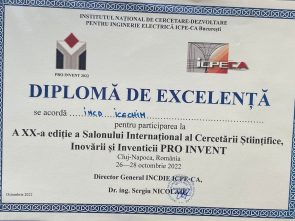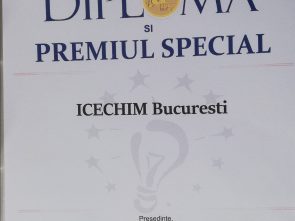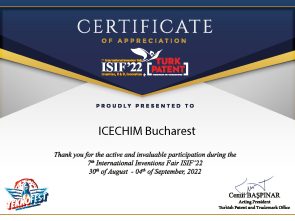Formulations of protective cosmetic products obtained by applying integrated and sustainable bioeconomy approaches
BioProtect
PN-III-P2-2.1-PED-2021-0273
(644PED/2022)
Chronic exposure of human skin to solar UV radiation is widely recognized as the key factor responsible for photo-ageing. For these reasons, the role of photoprotection is critical to avoid skin cancer and others undesired effects.
Project goal
The goal of the project BioProtect is to propose the use of nanomaterials both as active ingredient and delivery system of bioactive compounds (mixtures of phenolic compounds – rutin and quercitin) recovered from grape by-products for development of UV blocking cosmetic products.
Contracting authority: Executive Unit for Financing Higher Education, Research, Development and Innovation (UEFISCDI)
Implementation period: 21/06/2022-20/09/2024
Budget: 598.795 lei
Project director: Dr. Habil. Irina Fierăscu
Coordinator:
National Institute for Research & Development in Chemistry and Petrochemistry – ICECHIM Bucharest
Project director: Dr. Habil. Irina Fierăscu
Partner:
University POLITEHNICA of Bucharest,
Partner responsible: Dr. Eng. Aurelian Cristian Boscornea
The BioProtect project proposes the use of nanomaterials both as active ingredient and delivery system of bioactive compounds (mixtures of phenolic compounds – rutin and quercitin) recovered from grape by-products for development of UV blocking cosmetic products. Target molecules obtained through green technologies from grapes by-products can be used as potential active UV blockers in cosmetic formulations being delivered by apatitic materials.
Development of synthesis methods for the delivery system and adaptation of extraction methods for grape by-products.
Implementation period: 21/06/2022 – 31/12/2022
Activities:
- Development of synthesis and characterization protocols for the active delivery system;
- Assessment of potential grape waste with increased amounts of bioactive compounds;
- Isolation and purification of the target compounds from the extracts obtained;
- Evaluation of the possibilities of using the compounds obtained in cosmetic formulations;
- Results and project dissemination.
Development of the technology for obtaining sunscreen formulations with active delivery system and natural compounds.
Implementation period: 01/01/2023 – 31/12/2023
Activities:
- Evaluation of UV Blocker properties for active delivery systems;
- Evaluation of UV Blocker properties for natural compounds;
- Evaluation of UV Blocker properties for active delivery systems – natural compounds;
- Formulation and testing of sun protection systems;
- Results and project dissemination.
Demonstration and validation of the proposed solutions
Implementation period: 01/01/2024 – 20/06/2024
Activities:
- Demonstration of the effectiveness of the proposed formulations;
- Evaluation of results on a laboratory scale – making corrections and process improvements;
- Validation of laboratory technology by third parties;
- Development of technical documentation for the technology of obtaining cosmetic formulations and filing a patent application;
- Results and project dissemination.
Published papers
- Vizitiu, D.E.; Sardarescu, D.I.; Fierascu, I.; Fierascu, R.C.; Soare, L.C.; Ungureanu, C.; Buciumeanu, E.C.; Guta, I.C.; Pandelea, L.M. Grapevine Plants Management Using Natural Extracts and Phytosynthesized Silver Nanoparticles. Materials 2022, 15, 8188. https://doi.org/10.3390/ma15228188
- Baroi, A.M.; Sieniawska, E.; Świątek, Ł.; Fierascu, I. Grape Waste Materials—An Attractive Source for Developing Nanomaterials with Versatile Applications. Nanomaterials 2023, 13, 836. https://doi.org/10.3390/nano13050836
- Ana-Maria Drăghici-Popa, Aurelian Cristian Boscornea, Ana-Maria Brezoiu, Ștefan Theodor Tomas, Oana Cristina Pârvulescu and Raluca Stan, “Effects of Extraction Process Factors on the Composition and Antioxidant Activity of Blackthorn (Prunus spinosa L.) Fruit Extracts”, Antioxidants 2023, 12, 1897. https://doi.org/10.3390/antiox12101897
- Anca-Maria Roșca, Diana-Ioana Buliga, Aurelian-Cristian Boscornea, Optimisation of hypericin ultrasound assisted extraction:a mathematical model approach, U.P.B. Sci. Bull., Series B, Vol. 85, Iss. 4, 2023
- Baroi, A.M.; Toma, D.I.; Vlaicu, A.; Enascuta, C.E.; Fistos, T.; Matei, R.I.; Fierascu, R.C.; Fierascu, I. Green Approach to Synthesis of Silver and Gold Nanoparticles from Shoots and Pomace Waste Extracts. Proceedings 2023, 90, 2. https://doi.org/10.3390/proceedings2023090002
- Baroi, A.M.; Fierascu, R.C.; Fistos, T.; Matei, R.I.; Raduly, M.; Ditu, L.-M.; Fierascu, I. Topic Nanoformulations with Potential Cosmetic Applications. Proceedings 2023, 90, 11. https://doi.org/10.3390/proceedings2023090011
- Baroi, A.M.; Fierascu, I.; Ghizdareanu, A.-I.; Trica, B.; Fistos, T.; Matei, R.I.; Fierascu, R.C.; Firinca, C.; Sardarescu, I.D.; Avramescu, S.M. Green Approach for Synthesis of Silver Nanoparticles with Antimicrobial and Antioxidant Properties from Grapevine Waste Extracts. Int. J. Mol. Sci. 2024, 25, 4212. https://doi.org/10.3390/ijms25084212
- Luțu, O. A., Soare, L. C., Fierăscu, I., Fierăscu, R.-C., Dobrescu, C. M., Păunescu, A., Ponepal, C. M., Topală, C. M., Vîjan, L. E., Deliu, I., Negrea, A. D., Vîlcoci, D. Ștefania, Cîrstea, G., Aldea, F., Honțaru, S. O., & Șuțan, A. N. (2024). Phytotoxicity, cytogenotoxicity and antimicrobial potential of extracts with gold-silver bimetallic nanoparticles obtained from pteridophyte spores. Caryologia, 77(1), 65–82. https://doi.org/10.36253/caryologia-2424
Book chapters
- Role and application of nanosensors in crop protection for disease identification, Baroi, A.M., Ungureanu, C., Calinescu, M.F., Vizitiu D., Sardarescu I.D., Ortan A., Fierascu, R.C., Fierascu, I., Nanoformulations for Sustainable Agriculture and Environmental Risk Mitigation, 2023, pp. 118–141
Workshop
- Development of protective cosmetic products through bioeconomy approaches, within “Priorities of Chemistry for a Sustainable Development” PRIOCHEM XIXth Edition, 11-13 Octombrei 2023, Bucuresti, 25 participants, Book of Abstracts (pag 58), ISSN 2601 – 419X and ISSN-L 2601 – 4181 – English ed., CD-ROM, other Electronic Supports.
Patent application
- Cosmetic formulation for sun protection and with antimicrobial effect based on silver nanoparticles and natural extracts and its production process, Anda Maria Baroi, Irina Fierascu, Roxana Ioana Brazdis (Matei), Toma Fistos, Radu Claudiu Fierascu, Irina Elena Chican, Ioana Silvia Hosu, Florentina Monica Raduly, A0375/2023
- Active composite material with antimicrobial and sun protection properties with the potential for use in cosmetic formulations and procedure for obtaining, Irina Fierascu, Anda Maria Baroi, Radu Claudiu Fierascu, Roxana Ioana Brazdis (Matei), Toma Fistos, Ioana Silvia Hosu, Florentina Monica Raduly, A00069/2024
Scientific meetings
- IDEA (IDEA, Novelty, Invention and craft) International Exhibition, Abony, Hungary – Formulations of protective cosmetic products obtained by applying integrated and sustainable bioeconomy approaches (BioProtect), Irina Fierascu, Cristian Boscornea, Radu Claudiu Fierascu, Anda Maria Baroi (Gold medal)
- International Exhibition of Inventions and Innovations “TRAIAN VUIA – 2022 Timisoara – Formulations of protective cosmetic products obtained by applying integrated and sustainable bioeconomy approaches (BioProtect), Irina Fierascu, Cristian Boscornea, Radu Claudiu Fierascu, Anda Maria Baroi (Gold medal)
- 7th International Inventions Fair – ISIF’22 – Formulations of protective cosmetic products obtained by applying integrated and sustainable bioeconomy approaches (BioProtect), Irina Fierascu, Cristian Boscornea, Radu Claudiu Fierascu, Anda Maria Baroi (Silver medal)
- The International Symposium “priorities of chemistry for a sustainable development” PRIOCHEM – XVIII-th Edition. October 26-28, 2022, Anda Maria Baroi, Cristian Boscornea, Roxana Ioana Matei (Brazdis), Irina Fierascu, Toma Fistos, Radu Claudiu Fierascu, New cosmetic formulations obtained by applying integrated and sustainable bioeconomy approaches – BioProtect project
- 22nd Romanian International Conference on Chemistry and Chemical Engineering, Sinaia, ROMANIA – September 7 – 9, 2022, Agro-wastes – Opportunities and Perspectives in Development of a New Generation of Materials for Multidisciplinary Approaches, Anda Maria Baroi, Roxana Ioana Matei, Fistos Toma, Radu Claudiu Fierascu, Lia Mara Ditu, Sorin Avramescu, Raluca Somoghi, Irina Fierascu
- Physics of Materials – PM 7 2022, At the Frontier Between Materials Science and Biotechnology: Nanomaterials Phytosynthesis, I. Fierascu, R.C. Fierascu, A.M. Baroi, R.I. Matei (Brazdis), T. Fistos, I.C. Fierascu, I. Chican, I.S. Hosu (Invited lecture)
- International scientific Symposium CURRENT TRENDS IN NATURAL SCIENCES 2023, From nature to nanotechnology: nanomaterials phytosynthesis, Irina Fierascu, Radu Claudiu Fierascu, Anda Maria Baroi, Roxana Ioana Matei (Brazdis), Toma Fistos, Ioana Catalina Fierascu, Irina Chican, Ioana Silvia Hosu (invited key-note lecture)
- International Scientific Symposium CURRENT TRENDS IN NATURAL SCIENCES 2023, Capitalization of wine by-products for the development of nanomaterials with bioactive properties, Anda Maria Baroi, Alexandru Vlaicu, Cristina Emanuela Enascuta, Roxana Ioana Matei (Brazdis), Toma Fistos, Irina Fierascu, Radu Claudiu Fierascu
- Exploratory Workshop NeXT-Chem: “Innovative Cross-Sectoral Technologies” May 22-23, 2023, ROMANIA, Capitalization of wine by-products for the development of nanomaterials with bioactive properties, Anda Maria Baroi, Alexandru Vlaicu, Cristina Emanuela Enascuta, Roxana Ioana Matei (Brazdis), Toma Fistos, Irina Fierascu, Radu Claudiu Fierascu
- 5th International Conference on Natural Products Utilization: From Plants to Pharmacy Shelf – ICNPU, May 30-02 June 2023, Bulgaria, Natural compounds from grape wastes for pharmaceutics and cosmetic formulations, Anda Maria Baroi, Monica Florentina Raduly, Ioana Silvia Hosu, Bogdan Trica, Roxana Ioana Brazdis (Matei), Toma Fistos, Radu Claudiu Fierăscu, Irina Fierăscu
- Virtual International Scientific Conference on “Applications of Chemistry in Nanosciences and Biomaterials Engineering” NanoBioMat 2023 – Summer Edition, 28-30 June 2023, Development of Natural Extracts by Valorizing Agrotechnical Waste from Vineyards. Daniela-I. Sărdărescu, Radu C. Fierăscu, Diana E. Vizitiu, Anda M. Baroi, Alin Din, Irina Fierăscu, Cătălina I. Guță, Elena C. Buciumeanu
- Application of electron microscopy in the characterization of phytosynthesized nanoparticles, Radu Claudiu Fierascu, Irina Fierascu, Anda Maria Baroi, Roxana Ioana Matei (Brazdis), Toma Fistos, Irina Chican, Ioana Silva Hosu, (invited lecture), Conferința Societății de Microscopie Electronică din România – C.R.E.M.S, 18-21 Octombrie 2023, Cluj Napoca.
- Topic nanoformulations with potential cosmetic applications, Anda Maria Baroi, Radu Claudiu Fierascu, Toma Fistos, Roxana Ioana Brazdis, Monica Raduly, Lia-Mara Ditu, Irina Fierascu, “Priorities of Chemistry for a Sustainable Development” PRIOCHEM XIXth Edition, 11-13 Octombrie 2023, Bucuresti
- Formulations of protective cosmetic products obtained by applying integrated and sustainable bioeconomy approaches, PN-III-P2-2.1-PED-2021-0273 – Irina Fierascu, Cristian Boscornea, Radul Claudiu Fierascu, Anda Maria Baroi – INNOVERSE Innovation & Invention Expo 28-29 August 2023, Georgia Gwinnett, GA, USA, Certificate of Achievement & Gold Medal
- Formulations of protective cosmetic products obtained by applying integrated and sustainable bioeconomy approaches, PN-III-P2-2.1-PED-2021-0273 – Irina Fierascu, Cristian Boscornea, Radul Claudiu Fierascu, Anda Maria Baroi – The 8th International Invention Innovation Competition in Canada iCAN 2023, Toronto, Canada, 26 August 2023, Certificate of Achievement & Gold Medal
- Cosmetic formulation for sun protection and with antimicrobial effect based on silver nanoparticles and natural extracts and its production process, Anda Maria Baroi, Irina Fierascu, Roxana Ioana Brazdis (Matei), Toma Fistos, Radu Claudiu Fierascu, Irina Elena Chican, Ioana Silvia Hosu, Monica Florentina Raduly – INOVA, Zagreb, Croatia, 28 Septembrie 2023 – Gold Medal
- Cosmetic formulation for sun protection and with antimicrobial effect based on silver nanoparticles and natural extracts and its production process, Anda Maria Baroi, Irina Fierascu, Roxana Ioana Brazdis (Matei), Toma Fistos, Radu Claudiu Fierascu, Irina Elena Chican, Ioana Silvia Hosu, Monica Florentina Raduly – INVENTCOR 2023, Deva, 14-16.09.2023 – Gold Medal, Special Award – Satit Chula Innovation Society, Thailand
- Active composite material with antimicrobial and sun protection properties with the potential for use in cosmetic formulations and procedure for obtaining, Irina Fierascu, Anda Maria Baroi, Radu Claudiu Fierascu, Roxana Ioana Brazdis (Matei), Toma Fistos, Ioana Silvia Hosu, Florentina Monica Raduly, China (Shanghai) International Invention & Innovation Expo, 14.06.2024, Gold Medal
- Cosmetic formulation for sun protection and with antimicrobial effect based on silver nanoparticles and natural extracts and its production process, Anda Maria Baroi, Irina Fierascu, Roxana Ioana Brazdis (Matei), Toma Fistos, Radu Claudiu Fierascu, Irina Elena Chican, Ioana Silvia Hosu, Monica Florentina Raduly – Salonul International de Inventii Inovatii Traian Vuia Timisoara 2024- Gold Medal
- Cosmetic formulation for sun protection and with antimicrobial effect based on silver nanoparticles and natural extracts and its production process, Anda Maria Baroi, Irina Fierascu, Roxana Ioana Brazdis (Matei), Toma Fistos, Radu Claudiu Fierascu, Irina Elena Chican, Ioana Silvia Hosu, Monica Florentina Raduly – European Exhibition of Creativity and Innovation Euroinvent 2024, Iasi, Gold Meda
- Active composite material with antimicrobial and sun protection properties with the potential for use in cosmetic formulations and procedure for obtaining, Irina Fierascu, Anda Maria Baroi, Radu Claudiu Fierascu, Roxana Ioana Brazdis (Matei), Toma Fistos, Ioana Silvia Hosu, Florentina Monica Raduly, 2024 Japan Design, Idea & Invention Expo, 05-07.07.2024, Gold Medal
- Active composite material with antimicrobial and sun protection properties with the potential for use in cosmetic formulations and procedure for obtaining, Irina Fierascu, Anda Maria Baroi, Radu Claudiu Fierascu, Roxana Ioana Brazdis (Matei), Toma Fistos, Ioana Silvia Hosu, Florentina Monica Raduly, The XXVIIIth International Exhibition of Inventics, Iasi, Gold Medal
- Active composite material with antimicrobial and sun protection properties with the potential for use in cosmetic formulations and procedure for obtaining, Irina Fierascu, Anda Maria Baroi, Radu Claudiu Fierascu, Roxana Ioana Brazdis (Matei), Toma Fistos, Ioana Silvia Hosu, Florentina Monica Raduly, European Exhibition of Creativity and Innovation Euroinvent 2024, Iasi, Gold Medal
- Active composite material with antimicrobial and sun protection properties with the potential for use in cosmetic formulations and procedure for obtaining, Irina Fierascu, Anda Maria Baroi, Radu Claudiu Fierascu, Roxana Ioana Brazdis (Matei), Toma Fistos, Ioana Silvia Hosu, Florentina Monica Raduly, International Exhibition Inventcor 5th Edition, Gold Medal
- Active composite material with antimicrobial and sun protection properties with the potential for use in cosmetic formulations and procedure for obtaining, Irina Fierascu, Anda Maria Baroi, Radu Claudiu Fierascu, Roxana Ioana Brazdis (Matei), Toma Fistos, Ioana Silvia Hosu, Florentina Monica Raduly, Salonul international de inventii si inovatii Traian Vuia Timisoara, Gold Medal
- Valorization of viticultural by-products for the development of nanomaterials with bioactive properties, Anda Maria Baroi, Alexandru Vlaicu, Alin Cristian Nicolae Vintila, Cristina Emanuela Enascuta, Andra Ionela Ghizdareanu, Cristina Firinca, Toma Fistos, Roxana Ioana Matei (Brazdis), Maria-Lorena Jinga, Bogdan Trica, Ioana Silvia Hosu, Radu Claudiu Fierascu, Irina Fierascu, Exploratory Workshop NeXT-Chem: “Innovative Cross-Sectoral Technologies”
- Radu Claudiu Fierascu, Phytonanotechnology – a multidisciplinary research area, International Conference “Agriculture for Life, Life for Agriculture“, 13th edition, 6-8 June 2024 (invited lecture).
- Irina Fierascu, Radu Claudiu Fierascu, Daniela Toma (Sărdărescu), Anda Maria Baroi, Roxana Ioana Matei (Brazdis),Toma Fistos, Irina Elena Chican, Ioana Silvia Hosu, Lia Mara Dițu, Green Chemistry Nanomaterials for Increasing the Quality of Life, International Conference on Innovative Research, ICIR EUROINVENT, Iași, 6-7 June 2024.
Institutional & individual awards
Development of synthesis methods for the delivery system and adaptation of extraction methods for grape by-products
Summary
The grape industry, especially the wine industry, generates nutrient-rich by-products that are underutilized and often end up polluting the environment. After the extraction of grape juice, the remaining materials are currently not valued as highly profitable waste, being mainly dumped in open spaces, thus causing environmental problems.
In this context, the general objective of the project “Formulation of protective cosmetic products obtained by applying integrated and sustainable strategies of the bioeconomy – BIOProtect” is to propose the use of nanomaterials both as an active ingredient and as a system of delivery of bioactive compounds recovered from the by-products of the grape industry, for the development of cosmetic products, the target molecules obtained through green technologies being used as potential active UV blockers in cosmetic formulations that are “transported” by means of substituted hydroxyapatite.
The activities planned to be carried out by the partners during the first year of implementation were:
- Act 1.1 – Development of synthesis and characterization protocols for the active delivery system;
- Act 1.2 – Evaluation of potential grape waste with increased amounts of bioactive compounds;
- Act 1.3 – Isolation and purification of the target compounds from the obtained extracts;
- Act 1.4 – Evaluation of the possibilities of using the compounds obtained in cosmetic formulations;
- Act 1.5 Dissemination activities.
The deliverables assumed by the financing contract for Phase 1 of the project were completed in full, as follows:
- Synthesis and characterization protocols for the delivery system – obtaining and characterization;
- Reports on grape waste extracts;
- Report on isolation and purification of target compounds;
- Report on the preliminary assessment of the possibilities of obtaining sunscreen formulations
The obtained results were disseminated within the scientific community (1 paper published in Q1/Q2 ISI journal, 3 participations in international conferences, participation in trade fairs and exhibitions of invention and innovation), the dissemination results being widely presented on the project website (Romanian version – https://icechim.ro/project/bioprotect_ro/, English version – https://icechim.ro/project/bioprotect_en/); the project was also promoted through the newsletter weekly of the Ministry of Research, Innovation and Digitization (https://research.gov.ro/uploads/comunicare/buletin-informativ/2022/buletin-informativ-mcid-nr-43.pdf).
The proposed activities were carried out in full, supporting the continuation of the project in 2023.
Development of the technology to obtain sunscreen formulations with active delivery system and natural compounds.
Summary
Chronic exposure of human skin to solar UV radiation is widely recognized as the main factor responsible for photoaging. For these reasons, the role of protection is essential to avoid skin cancer and other unwanted effects.
The aim of the BioProtect project is to propose the use of nanomaterials both as an active ingredient and as a delivery system for bioactive compounds (mixtures of phenolic compounds – rutin and quercitin) recovered from grape by-products for the development of cosmetic products with UV blocking properties.
The activities planned to be carried out by the partners during the 2nd stage of project implementation were:.
- A2.1 Evaluation of UV Blocker Properties for Active Delivery Systems;
- A2.2 Evaluation of UV Blocker Properties for Natural Compounds;
- A2.3 Evaluation of UV Blocker properties for active delivery systems – natural compounds;
- A2.4 Formulation and testing of sunscreen systems;
- A2.5 Dissemination of results.
The deliverables proposed by the request and the financing contract for Stage 2 of the project were fully achieved (and even exceeded), as follows: Report on the properties of UV blocking for active delivery systems; Report on UV Blocking Properties for Natural Compounds; Report on UV Blocker Properties for Active Delivery Systems – Natural Compounds; Report on the characterization of the obtained cosmetic formulation; The second economic and scientific report to the Contracting Authority; papers in the ISI rated journal; participation in 2023; Workshop.
The obtained results were disseminated within the scientific community, being widely presented on the project website (Romanian version – https://icechim.ro/project/bioprotect_ro/, English version – https://icechim.ro /project/bioprotect_en/).
The proposed scientific activities were carried out in full, supporting the continuation of the project in 2024..
The degree of achievement of the objectives
No | Estimated result | Achieved result |
|---|---|---|
1 | Report on UV blocking properties for active delivery systems | The property evaluation report for the delivery systems (apatitic compounds – hydroxyapatite and iron-hydroxyapatite) was made. |
2 | Report on UV blocking properties for natural compounds | The property evaluation report for the natural compounds obtained from viticulture wastes was made |
3 | Report on UV Blocker Properties for Active Delivery Systems – Natural Compounds | The property evaluation report for the delivery systems – natural compounds was made |
4 | Report on the characterization of the obtained cosmetic formulation | The characterization report was made for cosmetic formulations based on natural compounds, FeHaP-natural compounds hybrid systems, but also alternative solutions of metal nanoparticles |
5 | Submission for publication of at least two ISI articles in Q1/Q2 journals | 2 ISI articles were published in Q1/Q2 journals and 1 article in a Q4 journal, 1 article sent for evaluation in Q1 journals |
6 | Participation in at least 3 scientific events | 14 participations in international scientific events were recorded (9 at scientific conferences and 5 at invention exhibitions) |
7 | Workshop organization | Development of protective cosmetic products through bioeconomy approaches (11.10.2023), within the “Priorities of Chemistry for a Sustainable Development” PRIOCHEM XIXth Edition, 11-13 October 2023, Bucharest |
8 | – | Patent application A0375/2023 was submitted |
9 | Project web page | The project website has been updated, both in Romanian and in English |
